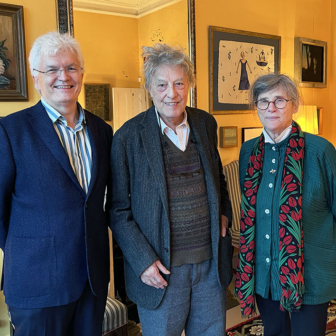As biographer and subject, Ann Powers and Joni Mitchell make perfect sense. Mitchell is widely considered to be the best female singer songwriter of all time, while Powers is revered as the female music critic. But though Powers has made a career from “contemplating what it means to be a ‘woman in music,’” for a long time she resisted the obvious pairing of “woman music critic” writing about “the woman demigod.”
As she writes in Travelling: On the Path of Joni Mitchell, Powers was more drawn to underdogs, to “messier” icons like Janis Joplin and Aretha Franklin, and to the New Wave “renegades” of her own generation like Kate Bush, Chrissie Hynde and Debbie Harry. Mitchell, in contrast, was for Powers, a “daunting figure, hard to identify with,” and “all the Joni worship” freaked her out. Nor did she want to write a standard rock biography, with its default settings of hagiography or hatchet job.
Powers is a critic, a “mapmaker” who “sets down lines meant to guide others,” not a biographer with aspirations to nail the definitive account of a legend’s life story. She is well versed in previous accounts — including fellow music critic David Yaffe’s troubled epic Reckless Daughter: A Portrait of Joni Mitchell (2017) — but they become part of her travels rather than works to define hers against.
From her predecessors, Powers is aware that getting too close to Mitchell, as seductive as it may be, creates its own set of problems, especially “if clarity is your goal.” Despite being an experienced and gifted interviewer — as evident in Piece by Piece (2005), an extended conversation between herself and singer-songwriter Tori Amos — Powers decides early on not to interview Mitchell or to seek her endorsement.
Not all biographical conventions are eschewed, however. With detours here and there, Powers broadly follows the chronology of Mitchell’s life from her 1940s and 1950s childhood and youth in chilly Saskatoon in Canada’s Prairie Provinces where she was born Roberta Joan Anderson, the “only child of somewhat distant parents,” a “popular kid who also spent a lot of time alone.” At age nine, Mitchell contracted polio during the same epidemic that also struck down Neil Young as a child. Later, both were among the plethora of artists who sang songs about childhood in the 1960s, in Mitchell’s case one of her best-known songs, with its poignant refrain “I’ve looked at life from both sides now.” A skilled “mapmaker” and cultural historian, Powers dexterously connects songs to places, to Mitchell’s life and to the spirit of the times.
Along the way, she dutifully interviewed various lesser-known and significant figures, among them folk singers Tom Rush and Judy Collins who first knew Mitchell when she was starting out in the American folk scene in the 1960s. Powers is alert to how “their stories unfolded in synch,” wryly noting that it’s “striking how many people played a role in the discovery of Joni Mitchell, as if she were a shoreline hidden and then reappearing in the mist.” She means no disrespect with such observations: they are offered as evidence of how myth-making works, and part of her myth-busting is to locate each participant in the Mitchell story in their time and place — whether they’re famous lovers like Leonard Cohen, Graeme Nash or James Taylor or a much larger cast of musicians she has worked with across the decades since her first studio album Song to a Seagull was released in 1968.
The Joni Mitchell most amenable to myth is the 1970s version, when the Canadian singer was at the centre of the “very heterosexual” Californian Laurel Canyon scene, setting up house with Nash after a brief romance with his bandmate David Crosby. Some of her most successful albums were released in the first part of the decade, including Ladies of the Canyon (1970), Court and Spark (1975) and of course Blue (1971), the album that set the benchmark for “confessional” songwriting.
Blue is quite possibly one of the most written-about albums in history, but Powers cuts through the cliches to present an analysis for the ages. Like the Beatles’ “Yesterday” or Leonard Cohen’s “Hallelujah,” she writes, Mitchell’s “River” is “the kind of pop song that serves a cultural need” in that it “captures what it is like to be sad, but also to question one’s right to be sad.” Its literary equivalent, posits Powers, is the “classic 1970 novel of women’s fatal sadness, Play It as It Lays, by Mitchell’s “literary twin” Joan Didion who, like Mitchell, was a “boy’s girl.”
As the impressive heft of Travelling indicates, though, there’s far more to Mitchell’s life than Laurel Canyon and Blue, and as much as those sections shine, Powers offers abundant riches throughout. She takes Mitchell seriously as an artist and as a woman; adeptly moving from a discussion of her distinctive guitar-playing to her evolving fashion sense and from her contributions to jazz fusion (among other genres) to her style of home decorating. She writes so evocatively about album and magazine covers and photographs of Mitchell that many readers will inevitably lament the absence of images — though they are easy enough to find (as is Mitchell’s music, now that she’s allowed it to be streamed).
When it comes to romance, Mitchell certainly had her short-term fun, but as Powers traces, she was constitutionally a “serial monogamist in art as well as in life” and often mixed work with pleasure. Noting her own tendency for projection, Powers is most drawn to the 1980s version of Mitchell, that time from 1982 to 1994 when she was (mostly) happily married to producer and musician Larry Klein. Boldly, Powers declares the music made in their marriage “the most overlooked in her body of work.”
In this revisionist spirit, Powers rearranges not just what we know about Joni Mitchell, but also the “current taxonomies” of modern pop music. Where many others have predictably compared Mitchell to Bob Dylan, Powers goes deeper in her coverage of Dylan’s Rolling Revue Tour, which Mitchell joined for a month in 1975. But she also moves beyond Dylan to compare Mitchell to Stevie Wonder. “Both were polyglots exploring new rhythms and extended melody lines,” she writes, who had “astounding album runs in the early-to-mid 1970s.”
Elsewhere, Powers grapples at length with Mitchell’s declared affinities to (and appropriations of) black and Indigenous music and cultures. On this front, there’s much to ponder, including Mitchell donning blackface to take on the “jazz cat persona” of a black man named Claude or Art Nouveau, immortalised on the cover of her 1977 double album Don Juan’s Reckless Daughter. Where previous biographers have briefly acknowledged the “blackface story,” Powers — a white woman who has written extensively about black music and the racial politics of popular culture — goes full tilt.
On another sensitive topic, Powers takes her cues from Mitchell. In 1965, on the cusp of fame, Mitchell gave birth to a daughter she named Kelly Dale, whom she briefly attempted to parent with her first husband Chuck Mitchell before giving her up for adoption. It’s a story laid out in the song “Little Green” on Blue, though at the time its content seemed to pass most male music critics by. In the 1990s — the same decade third-wave feminism and a new generation of female singer-songwriters “helped secure Mitchell’s new unsought stature as a pop matriarch” — her daughter returned to her life, now a grown woman named Kilauren Gibb, with a child of her own. Only then did Mitchell start publicly speaking about her. Powers, we learn, is an adoptive mother who knows that “every adoption story is different.” For her, these are stories which belong “only to those who’ve lived it.”
When Powers embarked on her travels with Joni Mitchell, it was in the recent aftermath of the singer’s debilitating aneurysm in 2015. Most of the book she wrote “during this time of her silence.” Its completion and publication however are part of the ongoing Joni Mitchell revival that peaked with the singer’s surprise and rapturously received performance at the 2022 Newport Folk Festival, accompanied by her greatest contemporary champion, Brandi Carlile, among others, for a “Joni Jam.” Powers could have been there, but she chose not to, maintaining instead a watchful distance.
The tribute Powers offers in Travelling is of a different order, born not of devotion or homage but of sustained attention and respect. Powers comes to see Mitchell as both a “real person” and as a genius in the oldest sense of the word, as it originated in Latin: “a guardian spirit associated with a time, place or community.” With genius presented as a gateway term, rather than an exclusionary one, Powers invites readers in to reflect not only on Mitchell and her music but also on the worlds artists like her have opened up and made possible. •
Travelling: On the Path of Joni Mitchell
By Ann Powers | Harper Collins | $34.99 | 480 pages




